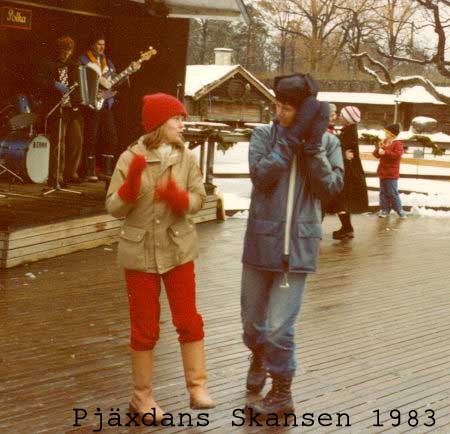Site index
About
Dance calendar
Dance courses
Noticeboard
Dance reports
Techniques
Improvisation
Schottishe
Hambo
Waltz
Snoa & Polka
Mazurka
Polskor
Modern Dance
Other
Links
..Courses
..Festivals
..Other
History
Blog
Outdoors
..Reports
..Walk Guide
..Mountain walks
Dogs
..Lava
Preferences
Login
Contact
Other Dances
- Contents: >Swedish traditional dances - varying Bingsjöpolska and Pariserpolka
- Description
Dance Instruction: Other Dances
Target Audience: Experienced dancers - Author: Örjan Wikström
- Genre: Dance (Swedish ´Gammaldans`)
Bingsjöpolska
Polskor are often so well adopted to the music and so demanding to dance, that it does not feel as important to vary them. But sometimes when a lot of polskor are played, it feels liberating to improvise for a while. Bingsjöpolska is nice for this purpose. Beyond the basic dance - turns, one leg and running steps, the following variants also suits well:
- Walking steps on all beats with freely varied movements and turns
- The quick turn done in the same way as the Quick turn in snoa, e.g. on the last beat of a theme
- Snoa - one step on each bar, that is three turns on two bars, clockwise and counter-clockwise
- Counter-clockwise. We do not use to mirror the bingsjöpolska steps, instead the leader step to his left foot on beat 1 and 2 with support from his right, step backwards on beat 3. From this position the normal Bingsjö clockwise turn can easily be resumed when the leader has his back in the dancing direction
Pariserpolka
Below some decorations and variations to pariserpolka are described. The number refers to the ordinary Pariserpolka sequence (1 - 5).
- (1) If there is plenty of space to the closest dancing couple in front of you, the four walking steps backwards can be replaced by hurra steps counter-clockwise. If possible try to combine this with moving backwards.
- (2) The hand clapping can be altered by either put your cheek in your hands.
Or just establish a light contact with the palm of the hand, which is more enjoyable than it sounds. At the turn backwards the leader can try to make two turns rather than one on one foot without support from the other one.
- (3) Occasionally the pancake turn can be interrupted when the couple is
headed with the backs against each other
- (4) The leader can also turn under the arms in both directions at the same time as the follower. A perhaps more amusing variant is that the leader gives the follower a more distinct momentum forwards in the dancing direction at the steps forwards, then bring her back at his left side without releasing the double hand hold, then turning her around one turn counter-clockwise. She will then be in the same position as when using the normal pattern. The variant ends with the follower turning two turns rather than one per bar, ended with a normal turn together.
- (5) Either the leader can turn under his own arm the bar after the
follower turns, both in the forwards and backwards movement. When it
feels appropriate, a pancake turn forwards can be used, or letting the
follower spin at the speed she can handle.
As an alternative one snoa turn can be added in bar 1, and then turn the follower only on bar 2. In such situations it is handy to stop the turn and start the turn in the other direction by using both hands, as her speed will be a little to high to be able to do this comfortably herself. At the turn backwards the leader can also turn himself outwards.
- (1) the second time: If the music does not end with 5 above, it is nice to
continue with the snoa at bar 1 and 2. At the end of bar 2 the couple
will stand with the side in the dancing direction with the leader outwards
and with the weight on the forwards feet. On bar 3 and 4 change direction
and dance snoa counter-clockwise and backwards. The leader starts with his
left foot on beat 1 in bar 3, the follower on her right. At the end of bar 4
the couple will once again stand with the side in the dancing direction,
this time the leader inwards the follower. From this position use polka
steps for two bars counter-clockwise forwards followed by two bars with snoa
counter-clockwise.
When tour (1) is repeated the counter-clockwise snoa continues for two more bars. At the end of bar 2 the leader will be located outside the follower with the weight on the forwards feet. During the next two bars snoa is danced clockwise backwards in the dancing direction. This is followed by two bars polka clockwise forwards, and ended by two turns snoa clockwise.
- (2) the second time: If the music lasts, the leader can do the follower's turns from tour 5 mirrored.
Last updated: Oct 25, 2014